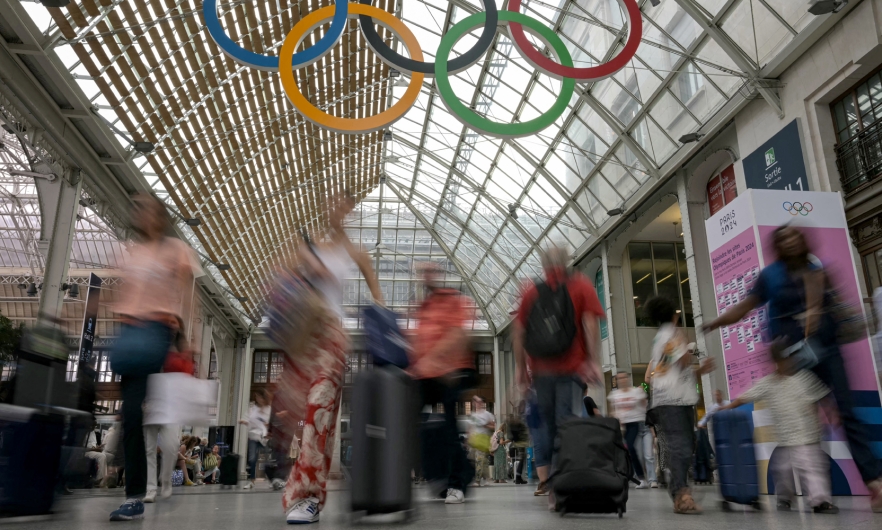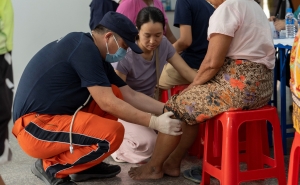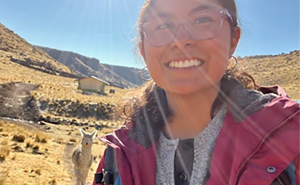Public Health Prep for the 2024 Paris Olympics
From COVID to crowd control: Mitigating public health risks at the Olympics starts with prevention.

Commuters walk under the Olympic rings at the Gare de Lyon train station, on July 23, 2024, ahead of the Paris 2024 Olympic and Paralympic Games. Carl De Souza/AFP via Getty Images
This week kicks off the 2024 Olympic Games in Paris, with thousands of athletes and spectators from around the world descending on the French capital for the 19-day event. The opening ceremony alone is projected to draw around 300,000 spectators, and more than 10 million people are projected to visit France for the Games.
Like any mass gathering event, there is a raised risk of public health threats. So how does the International Olympic Committee (IOC) mitigate these dangers—both before and during the competitions?
In this Q&A, adapted from the July 24 episode of Public Health On Call, Lucia Mullin, MPH, an associate scholar at the Johns Hopkins Center for Health Security and an associate in the Department of Environmental Health and Engineering, talks with Lindsay Smith Rogers about her role as a member of the WHO Collaborating Center for Global Health Security's mass gathering expert group, the inner workings of preventative public health measures during the Olympics, and insights gained from previous Games.
What are the public health implications of the Olympics?
The Olympics is what we refer to as a mass gathering: A large number of people are brought together, usually to one geographic space for a certain period of time, and often in a high density area. This brings a lot of health risks. We've got over 200 countries’ athletes participating and even more people coming as spectators. We know there's a heightened risk of infectious disease if we're bringing a lot of people together.
We also have a few other concerns. One is weather related: We are dealing with climate change, which means hotter summers, especially in Europe. And when we're having extremely high-level athletes competing in many outside events, we're going to have some worries about overheating.
Another concern: The Olympics are watched by millions, perhaps billions, of people around the world, and with that, there are some heightened security risks, from protests all the way to terror attacks.
There's a range of different risks that we need to consider in the planning phase for such events. This is often where the health sector will become involved with other branches of the government and event organizers to first identify what those risks are and then make plans to mitigate them.
What does one of these mitigation meetings involve?
The Olympics happen regularly. Planning starts years in advance. We also have the benefit of previous Games, and so we try to highlight insights gleaned from game to game. We'll often start with discussions that are facilitated by the IOC. They will come together with the host country and start providing platforms to bring in different experts and organizations.
The WHO will be involved from the international aspect. We'll always have the government’s national health agency involved, and then we'll have outside consultants and other experts that are often pulled on to provide technical expertise in certain areas. This is usually where risk assessments will happen, which starts that process of trying to identify what the risks are that we're most concerned about, so we can figure out how we can start countering them.
How do you approach safety for mass gatherings?
For the safety side of things, we've got a couple approaches. We've got to worry about crowd control. We've got to make sure there are enough entrances and exits, and that there are enough people monitoring to make sure that the crowd doesn’t panic, which could cause issues like stampedes.
With the Olympics, that's something that they've monitored for years, and are very good at making sure that there's enough mitigation measures in there. A lot of the venues that they're using are actually already standing venues. They already have these protocols in place, and they've also tested them.
Part of the Olympic prep for this is what they call test events. In the years leading up to the Games, they'll choose different sporting events to run some of these operations and protocols with similar types of numbers, in terms of spectators and athletes, to make sure that those protocols are up to date and are run properly. This also allows for opportunities to train the various staff members.
The other aspect that is harder to test, is the chemical, biological, radiological, and nuclear defense (CBRN defense) or terrorism response. There is a very low risk of it being needed, but because it has that international platform, there could be a high consequence event. So the [IOC] will have a lot of surveillance systems in place, and this is why they work very closely with the intelligence and law enforcement sectors, and a lot of that training is handed over to them.
France has hosted major events in the last few years, like the Rugby World Cup. It may not have seen the same number of people as we're expecting for the Olympics but we were able to see large numbers of people come together and it was a highly visible event. The surveillance that starts running months before and keeps going throughout the entirety of the event really helps lower the risk of security threats.
Aside from law enforcement and other agencies, who else might be at the table for some of these conversations about preparedness?
It's very much a multisectoral effort. On the government side of things, we may have the Ministry of Foreign Affairs and the Ministry of Interior present. We'll often have education and sports departments there. We may also have members of the private sector or NGOs who have been involved, as well as the food and medical sectors.
Can you tell me about the role that communication plays in all of this?
Yes, and it's very multifaceted. As with previous Olympics, we'll have a lot of media representatives from different countries come covering for the Games, as well as talking with the local population and other groups while they're there. Before the Games there is a lot of awareness raising, in terms of using these opportunities to promote different protocols in place that promote safe practices.
There are concerns about the risk of dengue infections in France. How are you addressing that at the Olympics?
It is something that is a risk, but it's not as near alarming as a lot of media is making it out to be. Dengue is a vector-borne disease, spread by mosquitoes traditionally not found in Europe. However, in recent years, due to climate change and increased global travel, we are seeing more and more of these mosquitoes in the European region, and in the past few years there have been records of more of them in France.
For quite a while, France has been increasing their dengue control and surveillance efforts. They've been setting lots of traps to monitor how many of these mosquitoes are around, and using vector control measures to kill off the insects. They're also embedding it into some of their surveillance measures. If we do start having cases of dengue, we will notice it.
How are insights from the last two Olympics informing this year’s Games?
[Working with the IOC,] we did a deep dive on the Tokyo 2020 and Beijing 2022 Games, which was largely focused on the efforts to minimize COVID-19 spread, but we really wanted to look at how some of those findings could expand beyond the pandemic. That included looking at how effectively different protocols were communicated.
The Tokyo 2020 Games actually occurred one year later than scheduled. This is the first time in history an Olympic game has been postponed for a health reason. This was to give the event organizers and the host country more time to understand the pandemic and the effectiveness of different mitigation measures, therapeutics, tests, and vaccines to effectively counter COVID-19—and be able to feel confident that they could host the Games in a safe way. Part of this included creating and continuously updating the public health protocols.
They now refer to these protocols as the “playbooks.” It is a “one stop shop” with all of the protocols, which our evaluation showed were very effective. That helped us realize that if we have another major public health event during an Olympic Game, having something that a variety of different audience members can refer to will help us.
Another prime example from these lessons learned was the effectiveness of basic hygiene. In our evaluation we found that while being very successful in limiting COVID-19 spread, hygiene also helped limit other diseases, especially other respiratory and gastrointestinal diseases. Having extra educational pamphlets around, a lot of hand hygiene stations, and [promoting a] safety mentality had helped decrease risk, and was something that we felt was a simple measure that we could continue to push at further events.
I think the final thing is the importance of surveillance. Tokyo or Beijing may have been the most in-depth surveillance we've done on the amount of testing and reviewing of COVID-19 cases, but we have used surveillance at other Games, and it can help us confidently know when something's happening and where it's happening, in order to quickly stop it.
This interview was edited for length and clarity by Morgan Coulson, an editorial associate in the Office of External Affairs at the Johns Hopkins Bloomberg School of Public Health.
RELATED:
- The 2022 Pandemic Olympics (Podcast)
- The Tokyo Olympics and COVID-19 (Podcast)





